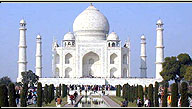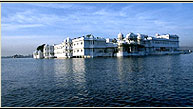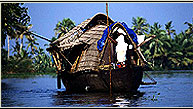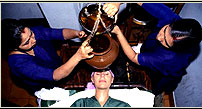Buddhist Sites
-| Bhaja | -
Location: Dist -Poona (Maharashtra) - Lat 18º 44'E, Long 73º
29 E
This site is significant for the group of 22 caves that are on a hill, near
the village Bhaja, 15 kms. from Malavli railway station on the Bombay Poona
railway line. The view from the caves, facing the valley of Indrayani river
with the two towering Maratha forts - Lohargarh and Visapur, along the adjoining
hill tops and with the Vulban Dam visible at a distance, is arresting. These
caves are the product of early phase of excavations alone, going back to the
period when the image of Buddha was not introduced here. The latest excavation
at Bhaja is a cistern, that can be referred to the end of the Second Century
AD on the evidence of style of inscription. The caves remained in use at least
till the 5th - 6th century AD which saw the embellishment of the Chaitya griha
with the painted figures of Lord Buddha.
The Chaityagriha has been regarded as the earliest of its class in live rock,
as it provides the closest copy of the wood prototype architecture transformed
in rock cut. Though the wooden facade below the chaitya arch and also the wooden
screen of the chaitya window have disappeared completely with passage of time.
Among the monasteries, cave 18 consists of a pillared veranda with a cell on
the right side and a recess on the left. A styler hall with a bench along the
left side and two cells on the back and right side provide an evidence of unusual
monastery in early phase. The columns of this monastery are square below, octagonal
in the middle with chamfering of the aisles. The ceiling of the veranda is arched
and seemingly rests on a frame of rock cut beams and rafters. The walls of the
hall are also embellished. The cell doors, which incline inwards are framed
with a motif resembling the facade of a chaityagriha. The remaining monasteries
are of the ordinary type with a veranda and a styler hall with cells on one,
two or three sides. The cells of these monasteries have in most cases benches.
The latter sometimes have small recess. The walls of the cells, in few instances,
have niches (alcoves). Perforated windows are also fairly common. The cave no.12
is the largest of the group.
Bhaja - Buddhist, Archaeology
in India
Reservation Form
 Log On To: Log On To: |



